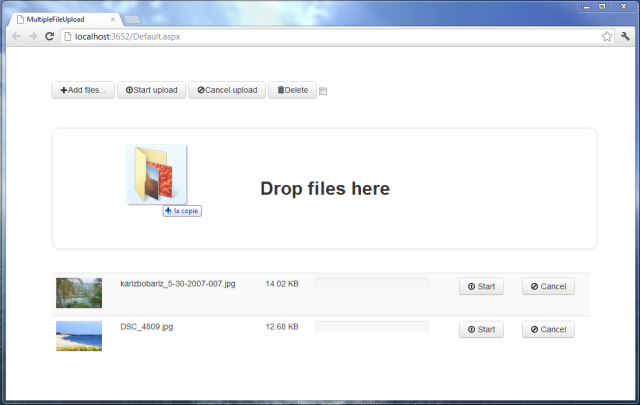

#.fileupload buttonbar full#
My goal here is to get much closer to using your full network bandwidth. For L=0.2, that would result in a maximum transfer rate of just 5KB/sec! It’s not enough just to wrap a BufferedStream around the source, since then you wouldn’t get progress notifications as often.
#.fileupload buttonbar code#
I often see code that reads data from streams in 1 KB chunks. If your round-trip ping time from client to server is L (e.g., L = 0.2 sec), and your SignalR message size is S (e.g., S = 32KB by default), then the tranfer rate cannot exceed S/L (in this example, 32/0.2 = 160 KB/sec), even if you have a terrabit network connection.Īdditionally, even if your SignalR message size is arbitrarily large, the I/O APIs you’re using might themselves use smaller buffers.

Since each chunk is being fetched sequentially, the maximum transfer rate becomes limited not only by network bandwidth, but also by network latency. As well as being inconvenient for developers, this still leaves a serious performance issue. Other libraries approaching this problem have required users to configure a SignalR message size greater than whatever maximum buffer size is used by the I/O APIs you’re using (e.g., the default for CopyToAsync is about 128KB). By default, SignalR’s maximum message size is 32KB. We have to fetch chunks via IJSRuntime which only allows JSON-serializable data, and imposes a limit on the size of each returned chunk. NET memory without needing any serialization.įor server-side Blazor (i.e., via SignalR), there’s a lot more going on. uses Blazor’s low-level unmarshalled interop APIs to copy the requested chunks of the binary data directly into.

NET is very simple and near-instant, since it’s all running locally. Implementation notesįor client-side Blazor (i.e., on WebAssembly), the data transfer between the browser’s JavaScript APIs and. … and now your event handler will receive a IFileListEntry that can contain multiple entries. You can use either server-side or client-side (WebAssembly).Īdd a dependency on the BlazorInputFile package in your. Or, custom UI including drag-drop support ( sample source):įirst, be sure you’re on the latest 3.0.0-preview9 version of Blazor, or newer if you’re reading this from the future. Or, multi-file upload and progress notifications ( sample source): Its features include uploading a single file ( sample source): I’ll talk about the challenges and solutions later in this post.Īs a possible starting point for a future built-in feature, I’ve published a NuGet package called BlazorInputFile ( source on GitHub), which provides a component called. There are simple ways to satisfy all the requirements above if you’re willing to accept greatly reduced upload rates. This is the hardest bit, not addressed by existing solutions as far as I know.… while achieving near-native-HTTP transfer speeds.NET APIs like Stream.CopyToAsync use much larger internal buffers, so the streaming logic needs to work with this and not require reconfiguration. By default, SignalR imposes a limit of 32KB for incoming messages, and. This is what several of the existing options don’t manage.Works independently of SignalR message size limits and file API buffer sizes.NET process, since we don’t want to depend on loading it all into memory at once. This must literally stream the content into the.NET Stream, so other code can handle it just the same as if it were a normal file on disk. Provides access to the file data as a regular.The file data needs to get into Blazor via the existing JS interop mechanism. Does not require setting up a separate server-side API endpoint.

What I want out of a great file input component is: It’s especially worth mentioning Tewr’s BlazorFileReader library, which does an excellent job and is quite similar to what I’m proposing in this post. There are already several open-source or third-party libraries in this area ( example from Rémi Bourgarel, example from SyncFusion). In server-side Blazor, your code is already running on the server, but you still want to be able to read files picked by the user. NET application’s memory, which can then edit it locally or could make an HTTP request to transfer it to some backend server. In client-side Blazor, you’re loading the file into the. It applies equally to client-side or server-side Blazor.


 0 kommentar(er)
0 kommentar(er)
